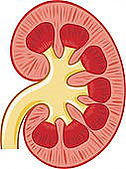General Information
Chronic kidney disease refers to a condition in which the kidneys have not been performing at least one of their main tasks adequately, resulting in blood or physical abnormalities. Normal kidneys filter the blood, removing wastes and excreting them in the urine. Kidneys in a diseased state lose some of this filtering ability, and waste products accumulate in the bloodstream. Continued re-circulation of this material results in illness. About ¾ of kidney tissue must be damaged before signs of illness appear. For this reason, kidney disease is often considered chronic (present for a long time) even though the affected pet may not have shown signs of the disease for very long. If routine yearly wellness screening of blood and urine is preformed, signs of kidney disease can be caught early and progression of disease can be slowed.
Signs of kidney disease can include:
- Weight loss
- Increased thirst
- Increased urination
- Decreased appetite
- Bad breath
- Depression/lethargy
- Vomiting or diarrhea
Continued illness without treatment can cause a uremic crisis (extremely high waste product accumulation in the blood) resulting in collapse, seizures, coma and death.
Though chronic kidney disease is progressive and not curable, it is often manageable. Many pets can live reasonably normal lives when properly managed in a cooperative effort between owner and veterinarian.
Diagnosis
Initially kidney disease is diagnosed with a combination of blood tests and a urine evaluation. Blood work involves looking at the waste products or enzymes produced by the kidneys (Creatinine and BUN), electrolytes, phosphorus levels and other organ values. A complete blood count helps evaluate a pet’s hydration level and can indicate if they are anemic (anemia can occur in later stages of kidney disease). A urinalysis can help us determine how concentrated or dilute a urine sample is and lets us know if there are any abnormal cells, bacteria or protein in the urine that might indicate a problem.
Once kidney disease has been suspected or diagnosed by blood tests, your veterinarian may order further testing to help determine how advanced the kidney disease is, or try to help determine the cause of kidney disease. These tests may include:
- Urine culture/sensitivity
- Blood pressure
- Infectious disease testing (leptospirosis/lyme)
- Urine protein:creatinine ratio (to determine the amount of protein being lost in the urine)
- Ultrasound of the kidneys (to look for stones or signs of cancer)
Kidney disease will progress, even with treatment. Because of this, close monitoring is required to help your veterinarian adjust your pet’s treatments. Your veterinarian will advise monitoring blood tests, blood pressures or urine tests at intervals to help tailor treatment best for your pet.
Management of Kidney Disease
In many cases, initial treatment involves flushing the blood with intravenous fluids to determine if kidney function can improve. This typically helps decrease the amount of waste product accumulation in the bloodstream, thus improving how a cat/dog feels. In the beginning, this is often done in the hospital. Once a pet is feeling well and kidney values have decreased, fluids can be given under the skin at home.
A prescription diet formulated for dogs/cats in kidney disease is critical to successful treatment. These types of diets come in dry and canned formulas.
Make sure your pet has free access to clean drinking water at all times. Good hydration is critical in managing kidney disease. Water fountains and multiple bowls around the house can be helpful in encouraging your pet to drink.
Medications can be prescribed for helping manage some of the symptoms of kidney disease. Depending on how your pet is being affected by kidney disease any of the following may be prescribed:
- Antacids
- Anti-nausea medications
- Phosphorus binders
- Antibiotics
- Appetite stimulants
Ask your veterinarian if you feel your pet could benefit from any of these medications.

